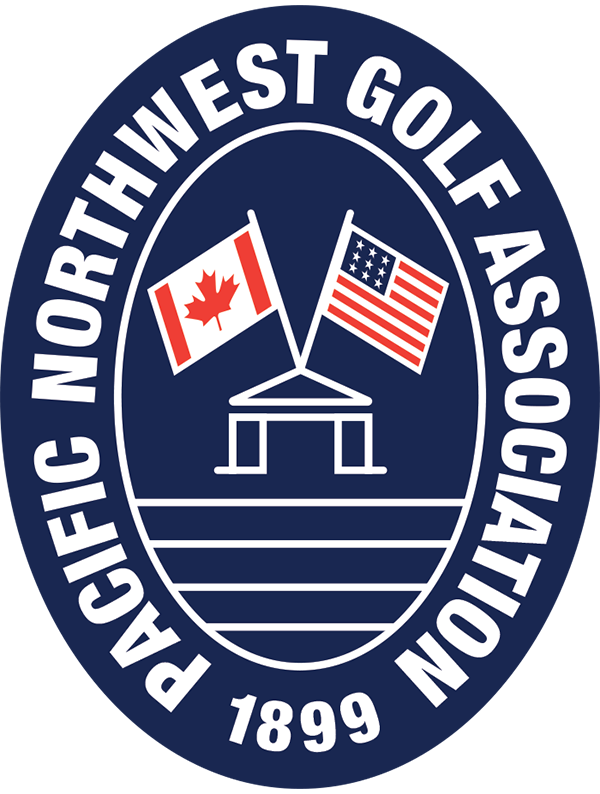For PNGA Hall of Famer Pat Lesser Harbottle, family over pro golf was an easy choice
by Patrick Hand
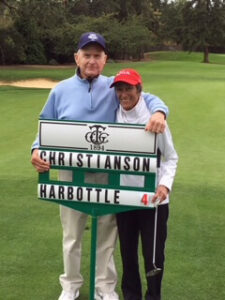
Pat Lesser was the wunderkind of American women’s golf in the mid-20th century. Winner of the 1950 U.S. Girls’ Junior and 1955 U.S. Women’s Amateur. Low amateur in three U.S. Women’s Opens. Member of the 1954 and 1956 U.S. Curtis Cup teams. Lesser more than held her own against some of the greatest names in women’s golf history – Zaharias, Wright, Berg, Suggs.
Lesser also was a pioneer in women’s sports. Decades before Title IX – when there were no women’s college golf programs – she attended a university with a big-time athletic program and competed on the men’s team, often as its No. 1.
Yet, Pat Lesser is all but forgotten in golf circles, a consequence of her decision in 1957 – at the age of 24 – to retire from top-flight competition to marry and raise a family. Happily, 67 years later, Pat Lesser Harbottle is still very much with us at age 90. Although she never turned pro, Harbottle is one of the last living links to the early days of the LPGA Tour.
Patricia Ann Lesser was born in Queens, New York, in August 1933 to Louis and Marguerite (née Vizner) Lesser. “Hungarian, French Canadian and Irish,” she said in an email of the gene pool that bequeathed lovely dark features from which she stood out among her contemporaries. “My parents and relatives call me Patsy – friends, Pat and Patsy.”
Her father was a career officer in the Army, her mother an Army nurse. At age 7, Patsy was introduced to the game by her father while he was stationed at Schofield Barracks in Honolulu, Hawaii. After Pearl Harbor, Patsy and her mother returned to the mainland. Upon his medical discharge in 1944, Colonel Lesser settled the family in Seattle, Washington, and shepherded his daughter’s development as a golfer.
Patsy first made national news in April 1947. “The world of women’s golf hasn’t heard yet from Patricia Lesser, but it might take a tip and put down the name of this 13-year-old Seattle girl for future reference,” declared an Associated Press news feature. “Pat has broken 80.”
The story told she shot 77 at Seattle’s Jackson Park municipal course using full-length men’s clubs – she was tall for her age, at 5-foot-5. An accompanying photo shows a tomboyish Patsy smiling broadly while holding her bag in jaunty, very non-traditional golf attire: long-sleeve checkered flannel shirt, blue jeans rolled up to knee-level, dark bobby sox, and what looks like a pith helmet covering long, wavy locks.
The AP story was prophetic.
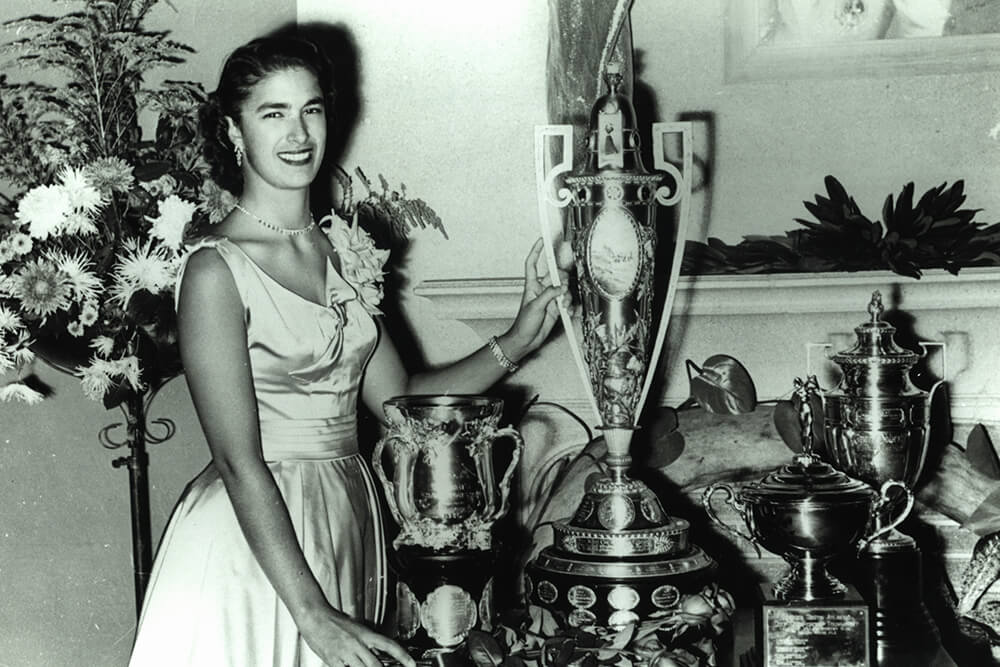
Eight years later, another photo shows an all-grown-up Pat Lesser as the 1955 Seattle Sportsman of the Year – she maxed out at 5-foot-6 – in an elegant gown, next to an impressive collection of hardware, including the Cox Trophy from her victory at the U.S. Women’s Amateur earlier in the year.
Lesser’s rise was swift. As a 14-year-old, she won the 1948 Seattle women’s championship, a title she successfully defended the following year. In August 1949 – just after turning 16 – Lesser was the medalist at the Canadian Women’s Amateur championship in Vancouver and advanced to the quarterfinals.
In the quarterfinals of the 1950 Women’s Western Junior in Winnetka, Illinois, Lesser beat Barbara McIntire – who would twice win the U.S. Women’s Amateur and play on six Curtis Cup teams – and went on to win.
Lesser next ventured to the U.S. Girls’ Junior at Wanakah Country Club in Buffalo, New York. In the quarterfinals, she beat Barbara Romack, who would win the 1954 U.S. Women’s Amateur. In the final, Lesser soundly defeated Mickey Wright – future victor in 13 women’s majors during an iconic World Golf Hall of Fame career – 4 and 2.
At age 18, Lesser contended at the 1951 U.S. Women’s Open at Druid Hills Golf Club in Atlanta, Georgia, tying for fourth with future hall-of-famer Marlene Bauer, seven shots back of winner Betsy Rawls, and behind only other future hall-of-famers Louise Suggs and Babe Zaharias. Lesser was the low amateur, and her 72-hole score of 300 established a record for amateurs.
“Her game here in the Open indicated Pat soon will be able to step into the company of Rawls, Zaharias, Suggs, Berg and associates,” wrote Joe Boyd in The Atlanta Journal. Instead, Lesser immediately headed home to embark on her studies at Seattle University.
Lesser excelled in the four other Women’s Opens she played in. She skipped the 1952 U.S. Women’s Open, instead playing and winning the Oregon Women’s Amateur held at the same time.
“My dad made out my schedule,” she said. Lesser was the low amateur again in the 1953 U.S. Women’s Open when she tied for sixth at the Country Club of Rochester in New York, 13 shots behind Rawls and Jackie Pung (Rawls won the playoff).
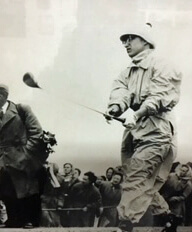
In the 1954 Open at Salem Country Club in Peabody, Massachusetts, Lesser tied for seventh behind Zaharias (who won by 12 shots in her final Women’s Open before dying of cancer in September 1956). In 1955, Lesser finished eighth (12 shots behind Fay Crocker at Wichita Country Club in Kansas), and she tied for 16th in 1956 at Northland Country Club in Duluth, Minnesota, won by Kathy Cornelius in a playoff over amateur McIntire (of all living former USGA champions – male or female – only Cornelius, at 91, is older than Harbottle).
For the Seattle University Chieftains (as they were then known), 1952 was historic. In March, Johnny O’Brien became the first NCAA basketball player to score more than 1,000 points in a season, as he led SU to a 29-7 record and a spot in the National Invitation Tournament (at the time more prestigious than the NCAA Tournament).
Another remarkable feat took place on April 18, 1952, when SU’s men’s golf team beat Oregon State, 13½-7½. What made an otherwise obscure dual meet noteworthy is that the Chieftains’ No. 1 player was pigtailed 18-year-old Lesser, who won her match. Two months later, Lesser was one of only 34 contestants at the Women’s National Intercollegiate Golf Tournament, where she lost in the semifinals. She would win the women’s college championship the following year.
Lesser played four years on SU’s men’s team – always from the men’s tees – and won far more matches than she lost. “It was a wonderful experience, and the fellows on the team accepted me as one of them,” she said.
Her status gave her entrance into LPGA tournaments. “Because there were so few pros, we amateurs played in all their tournaments to fill up the field,” she said. “We would compete with them and join them for meals.”
In May 1952, she played in a four-ball exhibition with Zaharias and two local male pros at the Olympic View Golf Club, a long-gone course overlooking Puget Sound. Lesser shot 75 on her own ball to beat Zaharias’ side, and remembers Zaharias addressing the gallery with her catchphrase – “Ladies and gentlemen, all you have to do is hitch up your girdle and let it fly” – during the match. “Babe was special. She loved to play the harmonica,” Harbottle said. “Babe would get her harmonica out, and we’d all sing along.”
Another immortal, Patty Berg, was a friend. Before the 1952 Weathervane Open in Seattle, one of Lesser’s SU teammates, John Harbottle, volunteered to caddie. Lesser introduced Harbottle to Berg. “Oh, so this is the boy you are going to marry!” Berg gleefully exclaimed. “You should have seen John’s face,” Harbottle said. “It got as red as a beet. She never forgot John’s name.” After John completed his studies and became a dentist, he did dental work for Berg.
In 1955, Lesser was at the top of her game. In July, she won the Women’s Western Amateur. Next up was the U.S. Women’s Amateur at Myers Park Country Club in Charlotte, North Carolina. She made quick work in the first round, winning 7 and 5. However, in the second round, Lesser was on the brink of elimination when 2 down to Marge Mason with two to play. After Lesser won the 17th hole with a par, she birdied 18 to tie the match before sinking a 10-foot putt on the 19th hole to win.
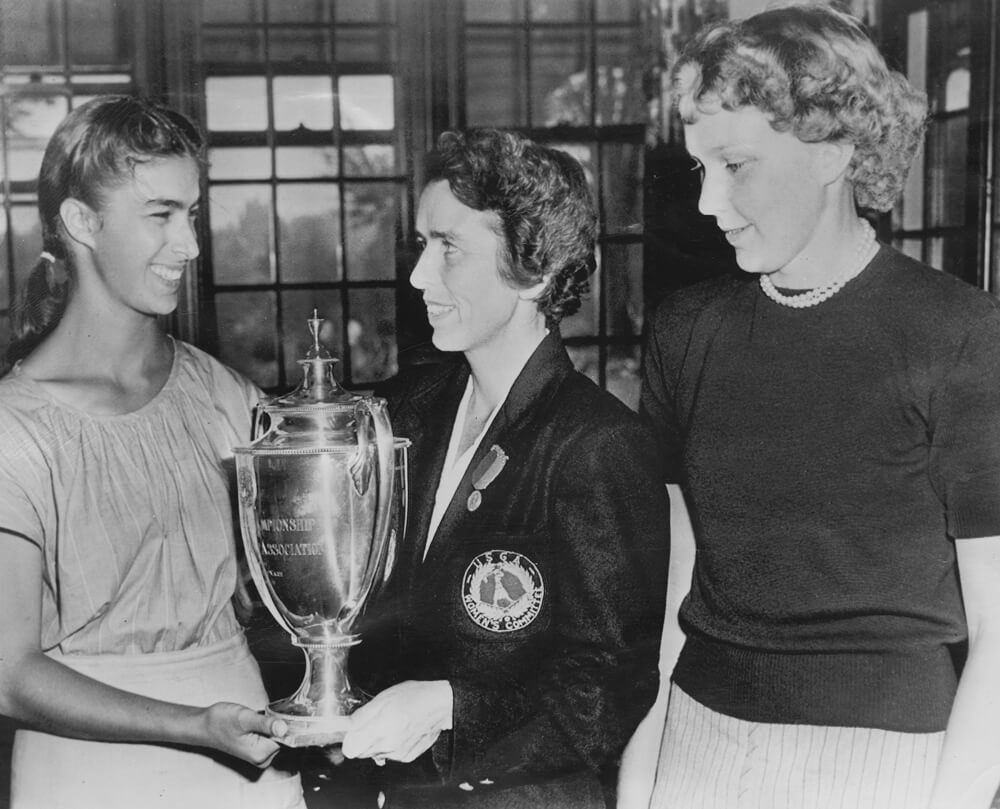
The next morning, Lesser ended her third-round match after only 11 holes, winning 8 and 7. The extra rest proved to be beneficial, as in the afternoon she needed 21 holes to beat Mary Ann Downey as dusk fell. “I guess I just got lucky, and it was my turn to win,” Harbottle said of the close matches. After that, she coasted. In the 18-hole semifinal, Lesser was 3-under on the front nine (despite a double bogey) and easily beat Polly Riley, 6 and 5. In the 36-hole final, she ousted Indianapolis schoolteacher Jean Nelson, 7 and 6, to claim the title.
Lesser graduated from Seattle University in 1956, where she was a member of the Kappa Gamma Pi honor society and maintained a B average. “I missed two quarters in 1954 and 1955 to play the Florida circuit,” she said. “Most were amateur tournaments, but the Titleholders was both professional and amateur.”
The Titleholders was played at Augusta Country Club (adjacent to Augusta National) and was discontinued after 1972, but is regarded today as a women’s major. Lesser tied for 11th at the 1954 Titleholders. In 1955, she tied for seventh (with Zaharias and Crocker) and was the low amateur. “It was wonderful playing with the pros,” Lesser said. “They treated us like equals, and of course it was great competition for us.”
Graduation would have been the time for Lesser to join the LPGA Tour, but she did not. “I never considered turning pro,” she said. “I always wanted to get married and have children.”
The grind of the tour would not have been conducive to family life. Moreover, women’s purses were minuscule even by the standards of the day. For example, the 1957 U.S. Women’s Open awarded a total of $7,200, with $1,800 to winner Rawls, whereas men’s Open winner Dick Mayer took $7,200 from the $30,000 purse.
In 1956, Lesser ventured to Indianapolis to defend her U.S. Women’s Amateur title at the Meridian Hills Country Club. She advanced to the third round, where she faced another Seattle-area player, 17-year-old JoAnne Gunderson, winner of the U.S. Girls’ Junior earlier in the year. The youngster overwhelmed Lesser, 5 and 4, and advanced to the final before losing to Marlene Stewart.
Patty Berg was prescient, as Lesser accepted John Harbottle’s marriage proposal. At the 1957 Amateur – her last – Lesser lost her third-round match, which allowed an early start on her August 31 wedding. Gunderson won the first of five U.S. Women’s Amateur championships before turning pro, and – as JoAnne Carner – won two U.S. Women’s Opens and earned a place in the World Golf Hall of Fame.
With Gunderson on the ascent, it was a good time for Harbottle to walk away from elite golf at the age of 24. “As for JoAnne, we were also good friends,” Harbottle said. “I played her three times and never beat her. She could drive the ball 50 yards past me. She is the best.”
Representing the U.S. in the Curtis Cup in 1954 and 1956 were highlights of Harbottle’s career. In 1954 at Merion, she won her only match, at foursomes, with Claire Doran, over three-time British Women’s Amateur champion Jesse Valentine and Philomena Garvey. The U.S. team won, 6-3. In the 1956 U.S. loss to the British Isles at Prince’s Club in Sandwich, England, Lesser – with Wiffi Smith – again defeated the Valentine-Garvey team. Lesser lost to Valentine in singles play.
“It was an awesome experience playing on the Curtis Cup,” Harbottle said. “Nothing can be better than playing for your country.”
The 1956 loss still resonates in her mind. “The USGA decided that we would go by ship [the SS America] to England rather than fly. Bad idea. We were on the ship for four to five days, only hitting balls into the ocean, while our opponents were practicing at Prince’s. It rained and was cold, gusts up to 60 miles an hour.”
After the Curtis Cup, Lesser stayed in the British Isles to play in the British Women’s Amateur for the only time, where she advanced to the fourth round before bowing to Angela Ward (later much better known as Lady Angela Bonallack, wife of hall-of-famer Michael Bonallack).
John and Pat Harbottle would have five children, 15 grandchildren, and to date seven great-grandchildren. Their oldest, John F. Harbottle III, was a well-known course designer who worked with Pete and Alice Dye before starting his own firm. Courses in Idaho, Utah, Washington, Oregon, California bear his imprint, the most notable being Palouse Ridge Golf Club (home course of the Washington State University golf teams), and the Olympic Course at Gold Mountain Golf Club in Bremerton, Washington.
The most tragic event of Harbottle’s long life is John III’s sudden death in May 2012 of cardiac arrest at age 53. “He was rated as one of the best young architects in the country,” Harbottle proudly said. “Not only that, he was humble and very well-liked by his colleagues and the people he worked for. We miss him very much.” John III also was a founder of First Tee – South Puget Sound. Their youngest child, Rob Harbottle, is the director of golf at BanBury Golf Course in Eagle, Idaho, a course designed by his late brother.
After she married, Harbottle stopped playing nationally except for a few USGA senior events. However, she continued to compete locally. She and John have been members of the Tacoma Country and Golf Club since the 1960s and for decades dominated club competition. Pat won the TC&GC club championship 23 times from 1965 to 2016, the last at age 83. “I will brag about this,” Harbottle said. “I have won at least one club championship in eight decades starting in the 1940s,” including club tournaments before joining TC&GC.
John has an impressive résumé in his own right. He won the TC&GC men’s club championship 17 times and shot his age more than 1,000 times – starting when he was 66 – through age 85, when he stopped counting. He was the low amateur at the 1982 U.S. Senior Open at Portland Golf Club and was runner-up in the 1986 U.S. Senior Amateur at Interlachen in Minnesota.
Pat Harbottle has been inducted into the Washington Sports, Pacific Northwest Golf and Seattle University Sports halls of fame. (John is also a member of the Pacific Northwest Golf Hall of Fame.) John no longer is able to play, and Pat reports that she, too, is curtailing her 84 years as an active golfer. However, the Harbottle name will live on. Since 2014, TC&GC has hosted the Pat Lesser Harbottle Invitational, a major NCAA women’s tournament held in October. And, since 2012, to honor John III, the Harbottle Golf Classic has been held to raise money for the First Tee – South Puget Sound.
(This article first appeared in Global Golf Post. Used here by permission.)
Patrick Hand has contributed to numerous publications including Golf Journal, The Washington Post, LA Weekly, and Washington City Paper, and is regular contributor to Global Golf Post+. He is a graduate of Catholic University in Washington, D.C., and Fordham Law School in New York.
